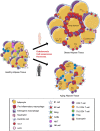The Immune Landscape of Visceral Adipose Tissue During Obesity and Aging
- PMID: 32499756
- PMCID: PMC7243349
- DOI: 10.3389/fendo.2020.00267
The Immune Landscape of Visceral Adipose Tissue During Obesity and Aging
Abstract
Obesity and aging represent major health burdens to the global adult population. Both conditions promote the development of associated metabolic diseases such as insulin resistance. The visceral adipose tissue (VAT) is a site that becomes dysfunctional during obesity and aging, and plays a significant role during their pathophysiology. The changes in obese and aging VAT are now recognized to be partly driven by a chronic local inflammatory state, characterized by immune cells that typically adopt an inflammatory phenotype during metabolic disease. Here, we summarize the current knowledge on the immune cell landscape of the VAT during lean, obese, and aged conditions, highlighting their similarities and differences. We also briefly discuss possible linked mechanisms that fuel obesity- and age-associated VAT dysfunction.
Keywords: aging; diabetes; immunology; immunometabolism; insulin resistance; metabolism; obesity; visceral adipose tissue.
Copyright © 2020 Khan, Chan, Revelo and Winer.
Figures

References
Publication types
MeSH terms
Grants and funding
LinkOut - more resources
Full Text Sources
Medical

